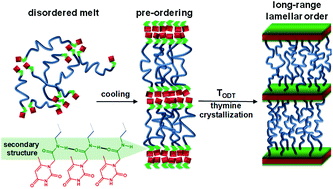Lamellar mesoscopic organization of supramolecular polymers: a necessary pre-ordering secondary structure†
Abstract
Thymine-functionalized telechelic poly(propylene glycol) (PPG) chains of 460–4000 g mol−1 present a long-range ordered lamellar microphase separation due to thymine crystallization. This organization is lost if the difference of polarity between the H-bonding units and the chain is not sufficiently high to induce segregation, as with a poly(ethylene glycol) (PEG) chain. Moreover, the mesoscopic order is gradually lost with the longest PPG chains i.e. with the smallest volume fractions of supramolecular units limiting their clusterization/crystallization. Methylated thymine (MeThy) end-functionalized PPG presents the same lamellar mesoscopic organization, proving that Thy/Thy H-bonding self-association does not drive their crystallization. Infrared spectroscopy evidences that the amide functions linking MeThy motifs to PPG chains interact with each other through H-bonds, forming either a random or an aligned pattern, just like protein secondary structures. On cooling from the melt, disordered H-bonded amides align and pre-order the supramolecular units just prior to the disorder–order transition driven by the MeThy crystallization. The close packing, necessary to induce crystallization, is no longer possible with bulky neo-pentyl functionalized thymines (tBuCH2Thy), preventing mesoscopic organization. Hence, the pattern formed by H-bonded amide links plays a major role in the long-range organization of the telechelic supramolecular polymer in helping supramolecular units to crystallize. Indeed, replacing the amide by an ester link suppresses their crystallization and thus the mesoscopic order.



 Please wait while we load your content...
Please wait while we load your content...